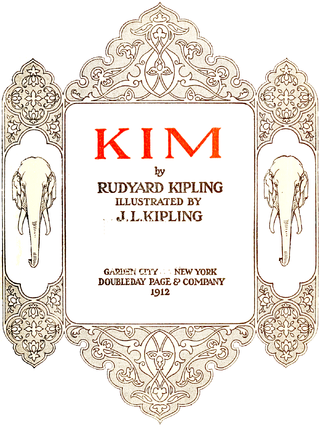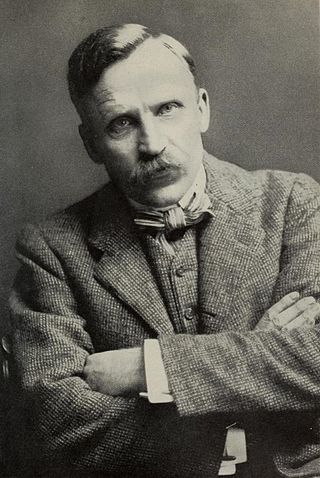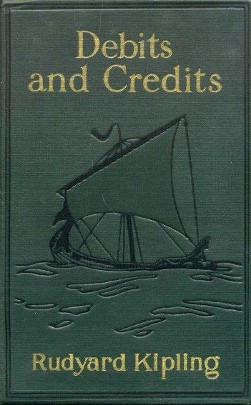Related Research Articles

Joseph Rudyard Kipling was an English novelist, short-story writer, poet, and journalist. He was born in British India, which inspired much of his work.
This is a bibliography of works by Rudyard Kipling, including books, short stories, poems, and collections of his works.

Kim is a novel by Nobel Prize-winning English author Rudyard Kipling. It was first published serially in McClure's Magazine from December 1900 to October 1901 as well as in Cassell's Magazine from January to November 1901, and first published in book form by Macmillan & Co. Ltd in October 1901. The story unfolds against the backdrop of the Great Game, the political conflict between Russia and Britain in Central Asia. The novel popularized the phrase and idea of the Great Game.
The United Services College was an English boys' public school for the sons of military officers, located at Westward Ho! near Bideford in North Devon. Almost all boys were boarders. The school was founded to prepare pupils for a career as officers in the armed services, many of them going on to the Royal Military College, Sandhurst, or the Royal Naval College, Dartmouth.

Westward Ho! is a seaside village near Bideford in Devon, England. The A39 road provides access from the towns of Barnstaple, Bideford, and Bude. It lies at the south end of Northam Burrows and faces westward into Bideford Bay, opposite Saunton Sands and Braunton Burrows. There is an electoral ward with the same name. The population at the 2011 census was 2,112.

The Aerial Board of Control is a fictional supranational organization dedicated to the control and aid of airship traffic across the whole world. It was first described in the science fiction novella by Rudyard Kipling, "With the Night Mail" (1905), and later in "As Easy as ABC" (1912.)
Roger Gilbert Lancelyn Green was a British biographer and children's writer. He was an Oxford academic who formed part of the Inklings literary discussion group along with C. S. Lewis and J. R. R. Tolkien. He had a positive influence on his friend, C.S. Lewis, by encouraging him to publish The Lion, the Witch and the Wardrobe.

Samuel Sidney McClure was an American publisher who became known as a key figure in investigative, or muckraking, journalism. He co-founded and ran McClure's Magazine from 1893 to 1911, which ran numerous exposées of wrongdoing in business and politics, such as those written by Ida Tarbell, Ray Stannard Baker, and Lincoln Steffens. The magazine ran fiction and nonfiction by the leading writers of the day, including Sarah Orne Jewett, Mark Twain, William Dean Howells, Joel Chandler Harris, Jack London, Stephen Crane, William Allen White and Willa Cather.

Eric, or, Little by Little is a book by Frederic W. Farrar, first edition 1858. It was published by Adam & Charles Black, Edinburgh and London. The book deals with the descent into moral turpitude of a boy at a boarding school or English public school of that era.

Major General Lionel Charles Dunsterville, was a British Army officer, who led Dunsterforce across present-day Iraq and Iran towards the Caucasus and Baku during the First World War.
".007" is a short story by Rudyard Kipling. It is a story in which steam locomotives are characters, somewhat like the later, better-known tales of The Railway Series by Wilbert Awdry and his son.

Debits and Credits is a 1926 collection of fourteen stories, nineteen poems, and two scenes from a play by Rudyard Kipling, an English writer who wrote extensively about British colonialism in India and Burma. Four of the poems that accompany the stories are whimsically presented as translations from the "Bk. V of Odes" by Horace, but are actually poems by Kipling imitating the style of the Roman poet.
"Lispeth" is a short story by Rudyard Kipling. It was first published in the Civil and Military Gazette on 29 November 1886; its first appearance in book form was in the first Indian edition of Plain Tales from the Hills in 1888, and it later appeared in subsequent editions of that collection. The tale is an interesting example of Kipling's attitudes to different races and cultures, which is less simple than many accounts of his beliefs allow.

George Charles Beresford was a British studio photographer, originally from Drumlease, Dromahair, County Leitrim.
William Carr Crofts was an English schoolmaster and rower who won the Diamond Challenge Sculls at Henley Royal Regatta twice and was an influential teacher of Rudyard Kipling.

The Windsor Magazine was a monthly illustrated publication produced by Ward Lock & Co from January 1895 to September 1939.
The Kipling Society is a literary society open to everyone interested in the work and life of British author Rudyard Kipling (1865–1936). The Kipling Society focuses on Kipling and his place in English Literature, and as such attracts members from all over the world, both general readers and academic researchers.

George Wylie Hutchinson (1852–1942) was a painter and leading illustrator in Britain and was from Great Village, Nova Scotia, Canada. He illustrated the works of Arthur Conan Doyle, Rudyard Kipling, Hall Caine, Robert Louis Stevenson and Israel Zangwill. His paintings inspired the poem "Large Bad Picture" and "Poem", both by Elizabeth Bishop, his great grand niece. Hutchinson was a contributor to and subject of the novel The Master (1895) by Israel Zangwill, with whom he was a close friend.
Galfrid Clement Keyworth "Stalky" Dunsterville was a business executive and a botanist who studied the orchids of Venezuela.
References
- ↑ "Stalky & Co.: The general background", Roger Lancelyn Green
- ↑ Orwell, George (1940). "Boys' Weeklies". Inside the Whale and Other Essays. Victor Gollancz Ltd.
- ↑ Kipling, Rudyard. "Land and Sea Tales: Stalky". www.telelib.com. Retrieved 19 January 2016..
- 1 2 3 "Boy-Society in Rudyard Kipling's Stalky & Co.", Lynne M. Rosenthal, The Lion and the Unicorn (journal) Volume 2, Number 2, 1978 pp. 16–26
- ↑ Green, Roger Lancelyn (1961). "Some Notes on the Characters". Kipling Society. Retrieved 19 January 2016.
... or rather, like the essence of Crofts distilled with genius, with the perspective of more than thirty years to colour even Kipling's recollection of the real man. The first written of the stories, "Slaves of the Lamp", suggests that to begin with Kipling's "mixture" for King contained a large percentage of Crofts, but with a certain admixture of Mr. F. W. Haslam...
- ↑ Livingston, Flora V. (1972). A Bibliography of the Works of Rudyard Kipling (1881–1921). Vol. 2. London: Haskell House. p. 48.
- ↑ Green, Roger Lancelyn (2 April 2003). "Slaves of the Lamp, Part I". Kipling Society. Retrieved 21 January 2016.
This was the first 'Stalky' story to be published, and possibly the first to be written. It first appeared in Cosmopolis in April 1897, and was subsequently collected in Stalky & Co. (1899) It was later included in The Complete Stalky & Co. (1929) It is twinned with "Slaves of the Lamp Part II", in which the tactics used by Stalky against his enemies at school are used again with great success on the North West Frontier of India.
- ↑ Livingston, Flora V. (1972). A Bibliography of the Works of Rudyard Kipling (1881–1921). Vol. 2. London: Haskell House. p. 48.
'Slaves of the Lamp, Parts I & II,' McClure's Magazine , August, 1897).
- ↑ "The English Flag". The Kipling Society. 2 April 2021. Retrieved 16 March 2022.
- ↑ Green, Roger Lancelyn (17 February 2003). "Slaves of the Lamp, Part II". Kipling Society. Retrieved 21 January 2016.
- ↑ List of Stories
- ↑ "Stalky"
- 1 2 Richards, Jeffrey (1988). Happiest Days: The Public Schools in English Fiction. Manchester University Press. p. 162.
- ↑ Buchanan, Robert (December 1899). "The Voice of 'The Hooligan'". The Contemporary Review. LXXVI: 773–789.
- ↑ Roosevelt, Theodore (May 1900). "What We Can Expect of the American Boy". St. Nicholas. Retrieved 7 August 2016.
- 1 2 Kipling, Rudyard (1987). The Complete Stalky & Co (Oxford World Classics, with an introduction and notes by Isabel Quigly ed.). Oxford: Oxford University Press. ISBN 9780192816603.
- ↑ Wells, H. G. (1934). Experiment in Autobiography. Victor Gollancz Ltd.
- ↑ Wells, H. G. (1920). The Outline of History. Vol. 2. George Newnes. pp. 423–424.
- ↑ Le Gallienne, Richard (1900). Rudyard Kipling: A Criticism. London and New York: John Lane: The Bodley Head. p. 70. Ellipsis by Le Gallienne.
- ↑ Kipling, Rudyard (1968). Stalky & Co (Laurel Leaf Library. With an introduction and glossary by John Rouse ed.). New York: Dell Publishing Co.
- ↑ Rouse op. cit., page 8. "One of the most popular novels of school life in Kipling's time was Frederick Farrar's Eric, or Little by Little, a book that went through nearly fifty editions in as many years. It is a novel that Stalky & Co. know very well and constantly ridicule. Eric's troubles begin one night in the dormitory when he listens to boys swearing and fails to warn them about the dangers of foul language. From there on it's moral decay all the way."
- ↑ The Kipling Society
- ↑ Scylla and Charybdis - Reader's Guide (The Kipling Society)
- ↑ The Haileybury Connection, Andrew Hambling, 2004
- ↑ Milner, Catherine (22 February 2004). "Kipling's 'missing Stalky and Co. chapter' found in school library". The Telegraph (online) . London: Telegraph Media Group . Retrieved 21 January 2016.